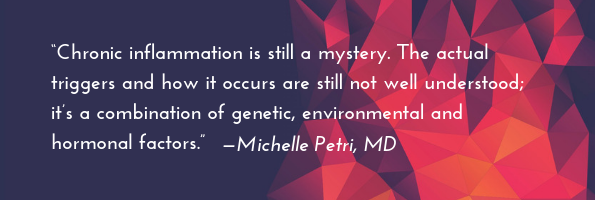And, in a 2017 interview with the American Association for Cancer Research, addressing the correlation between chronic inflammation and cancer, molecular biologist Michael Karin said, “When inflammation goes on for a long time, it can stimulate the growth of cancer cells. This chronic inflammation also inhibits people’s immunity, suppressing the ability of the immune system to recognize cancer as foreign and reject it.”
Extinguishing the fire
Although it’s somewhat difficult to detect the “silent fire” of chronic inflammation, the body offers a number of clues if you’re paying attention.
“Excess inflammation in the body can cause weight gain, especially in the belly; low energy; a mental fog; and an overall ‘blah’ feeling,” Shah says. It can also lead to fatigue, digestive issues, depression, sleep issues, and random aches and pains.
If you’ve been feeling “blah” and there doesn’t seem to be an explanation, Nielsen and Shah advise that the first course of action is to schedule a thorough checkup with your primary care doctor.
“When I’m working with patients, the first step is to determine whether their bodies are inflamed,” Shah says. “I assess things like whether they’re experiencing fatigue, insomnia or bloating, and if they have conditions like allergies, asthma or eczema that are getting worse. Results from certain blood tests can also indicate inflammation.”

Nielsen specifically recommends asking for a blood test to check for C-reactive protein, or CRP for short. “It’s a measure of chronic inflammatory response,” she says. “If your levels of CRP register at all, you’ve got some inflammation to fight.” (There are a number of other tests that your doctor might order as well, but no one test gives a complete picture.)
After chronic inflammation is diagnosed, Nielsen and Shah both help people adopt an anti-inflammatory lifestyle, a major component of which is diet.
An anti-inflammatory diet, Nielsen says, is largely a plant-based one. “The digestive tract is a primary target for anti-inflammatory efforts, as 80 percent of the immune system is located within the gut, and gut microbes can drive inflammation.” (See “Eat to beat inflammation” for Nielsen’s eating tips.)
There are four main goals of an anti-inflammatory diet, explains Nielsen. “You want to keep blood sugars balanced, eat the right types of fats, consume anti-inflammatory phytochemicals and promote a healthy gut flora.”
After Lora Fisher of Santa Barbara, California, was diagnosed with chronic inflammation, she cut out flour, high-salt foods and added sugar, and started eating more whole foods. “I felt better within a few weeks,” she says, “and I learned which foods will trigger the pain and swelling. I now know to avoid those foods, and I know I’ll be sorry if I do consume them.”
While carefully monitoring what you eat is crucial for reducing inflammation, Shah and Nielsen agree, there are other steps to take, including adopting a relaxing, presleep ritual; learning how to breathe deeply during periods of stress; exercising more; and reducing caffeine and alcohol intake.
“The good news,” Shah adds, “is that making a few small changes, for just a few minutes each day, can help to dramatically lower inflammation levels in the body.”